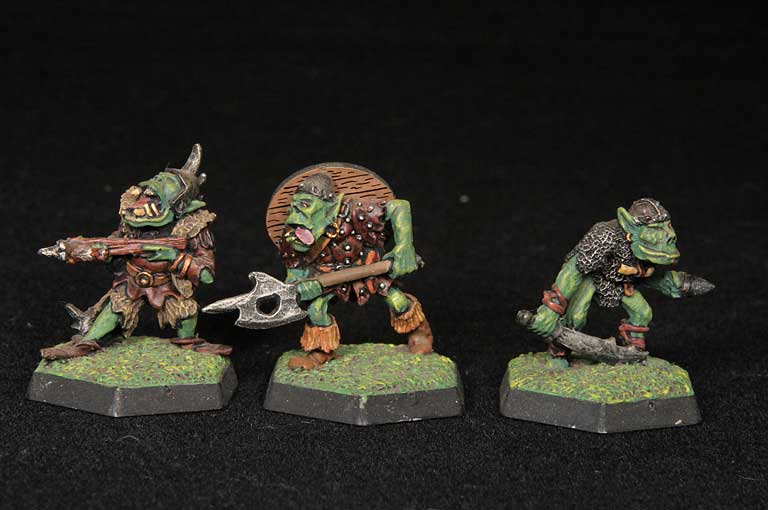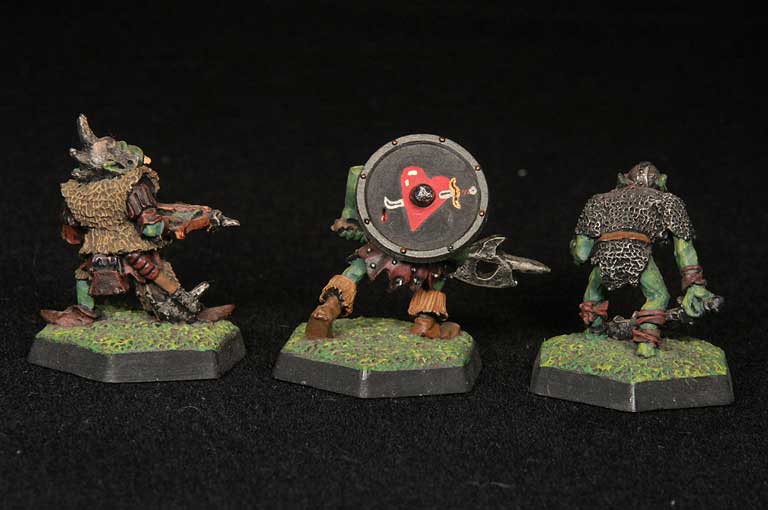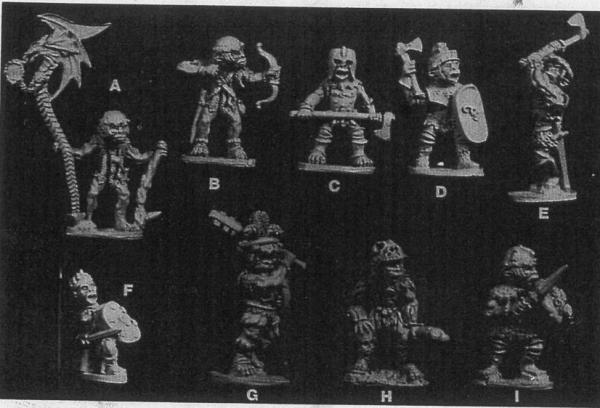
| Orcish Genealogy and Taxonomy | Makes of Orcs | Painting Orcs | Gaming Orcs | - |
| Dungeons & Dragons | Dragon magazine | - | Monsters | The Dragon #25 |
ADD53 Orcs

Representing as they do the bulk of an evil army, orcs are very
important to the fantasy miniaturist; but since the acutal appearance
of
an orc is a matter of opinion, the gamer is forced to choose among
a
wide variety of styles to obtain his orcs. The only source on
orcs that I
know of is LOTR, and Tolkien left wide room for interpretation.
Beacause
of this the miniaturist must make his own interpretation in the
end.
But before you, the present or prospective fantasy miniaturist,
make your final choice, consider the following ideas.
Orcish Genealogy and Taxonomy
Orcs are a member of a "family" of evil creatures; kobolds, goblins,
hobgoblins, orcs, and ogres. Gnolls and trolls are closely related
to
each other, but not to the "goblin races." Their
evolutionary progress
might be like this:
Orcs are themselves a genus of various species, subspecies, and
breeds. No 2 orcs need look alike any more than a Basset Hound
looks like a St. Bernard. Of course there are limits to size,
build and cast
of face which excludes some makes of orcs, but under this system most
every type of orc, goblin, hobgoblin, ogre, and kobold can be included.
It is also useful to break the genus orkus into three main species;
Orkus Superus, the Great orcs and Uruk-hai of Mordor; Orkus
commus,
the lesser and snaga orcs; and Orkus Homus, the half-orcs or
man
orcs. Orkus homus is a contrived name as every tribe of man
orcs had to
be specially bred by some powerful evil magician, and the tribes can't
generally inter-breed.
Using this system, most makes of orcs would fit below.
Genus Koboldus - up to 4 feet tall (20 mm).
Kobolds are extremely small and wiry creatures, much like Gollum.
They live in small hills for which possession they war with gmomes.
They hate the sun more for its denying them hiding places than for
the
light itself.
Genus Ogrus - 6' + tall (30 mm and up).
Any very large and ugly creature that isn't a gnoll or troll is an
ogre.
Ogres can get to be as tall as giants. Ogres are often found
in confederation
with orcs.
Genus Goblus - Goblins - 3 to 5 feet tall (15-25 mm).
Goblins are small man-like creatures, ugly and fanged. They live
in
mountains in alliances with hobgoblins. They don't like dwarves
and
dwarves don't like them.
Genus Hoblus - hobgoblins - 5 to 7 feet tall (25-35 mm).
Hobgoblins are simply large goblins. In many tribes the ruling
members finally differentiated into hobgoblins. Hobgoblins share
the
hatred of dwarves but they're smart enough not to attack without thinking.
Genus Orkus - Orcs
Orkus Commus - Lesser orcs - up to 4' tall (20 mm).
Small, broad, long-armed and hideous, lesser orcs comprise the
bulk of most evil armies. They normally live in mountains.
They don't
like elves, dwarves, men, the outside, the light, or each other.
Orkus superus - Great Orcs - 4 to 6 feet (20-30 mm).
Large, broad, long-armed and hideous, great orcs tend to be better
in a fight, and perform more militarily.
Orkus homus -Man Orcs-five or six feet tall (25-30 mm).
Man orcs tend to have more human proportions than other orcs.
They also suffer the light better and fight in military formations.
Remember that the smaller goblin races often ride wargs, very large
corrupted wolves (corrupted because I like to think of wolves and bassically
good, in the Jungle Book traditions). Larger races
may ride other
mounts.
Makes of Orcs
I list below most major makes of orcs and related races and how I
apply this system to them.
Orc War Wyvern (Monster Level VI)
Citadel Miniatures (Games Workshop)
Miniature Figurines (Middle Earth) -- ME 1, 9, 41 -- Man orcs,
great orcs.
Good luck finding any of these figures, I think the line is discontinued,
but they are good figures for man orcs, carrying large shields and
wearing full chain. Highly adaptable for the shield is blank.
Mini Figs -- ME 24, 25, 45 -- True orcs, Snaga orcs.
These are of the same line as above, so they may be hard to get.
The figures are all together too small for orcs, they make better kobolds.
Mini figs - ME 15, 16, 50 -- Goblins
Again these figures are too small for goblins, but they make excellent
kobolds. Since the first 2 are mounted on wargs they give the
kobolds an effective cavalry arm.
Mini Figs -- ME 56 -- Large Goblin
This figure can be used as a goblin, man, orc, or as I do, a very large
kobold.
Mini Figs -- ME 11, 21 -- Trolls
Use these figures as hobgoblins or ogres.
Heritage-Fantastiques -- Snaga Orcs
These figures are best used as snaga orcs, but their broad grins,
sometimes known as "snaga smiles" tend to make them appear farcical.
Otherwise they are good figures, coming in many poses and
weapons, their shields are blank as well.
Heritage-Fantastiques 1004-1006 -- Man orcs
These figures can be used as great orcs or hobgoblins, but they
don't make good man orcs.
Heritage-Fantastiques 1027 -- Variags of Khan?
When I finally identified these figures I had used them as something
else. They can be man orcs, hobgoblins or orcs.
Ral Partha -- Warriors, Wizards and Warlocks 611, 612, 613, 621,
622, 623, 631, 632, 651, 652, EW 641, 642- Snaga Orcs, Great Orcs,
and Goblins.
I have been told that these figures resemble beardless dwarves, in
any case they are excellent for orcs, great and lesser; but don’t use
the
goblins as goblins, but as more orcs.
Grenadier -- Wizards and Warriors W15-18 Orcs.
From what I have seen these are fairly good orcs.
Grenadier -- Wizards and Warriors W19-21 — Goblins.
Again these appear to be good goblins.
Garrison -- SS 77 -- Great Orcs.
These figures are too small and skinny to be great orcs, use them as
man orcs.
Mini Figs -- D&D set 7 -- goblins.
These seem to be good goblins, though they may be so small that I
would use them as kobolds.
Mini Figs -- D&D set 8-10 -- Hobgoblins.
These are best used as hobgoblisn, they don't fit any other role.
Mini Figs — D&D set 11-13 — Orcs.
Much as I like Dave Sutherland’s work, pigs are not my idea of
orcs, so if I ever buy these figures, and no doubt I will, I’ll use
them as
were-boars.
Mini Figs -- D&D set 16 -- Kobolds.
Again these figures look too much like animals, I'd use them as
were-jackals.
Archive Miniatures -- 513-515, 518-520 -- Goblins
These are small but passable goblins, the last 3 are mounted on
wargs.
Archive Miniatures -- 524-530, 541-543 -- Low Orcs.
Low is right, these are bad for orcs, like Mini Figs' D&D
orcs, these
have ridiculous snouts; I use them for what they look like, lizardmen.
Archive Miniatures — 535-536 — Orcs.
These figures are like Archive’s, low orcs, lizard snouted; I use them
for superior lizardmen.
Archive Miniatures — 630 — Boar Troll.
I use this figure for a hobgoblin to go with Archive’s other goblins,
note that the figure is mounted on a very large boar.
Heritage-Lord of the Ring Miniatures — Orcs.
These figures are certainly a departure from the common conception
of orcdom. They are easily hideous enough for orcs, in fact they are
almost comically ugly. Their large size and completely inhuman aspect
makes them useful only as great orcs, despite the fact that some are
labeled as a man orcs. One figure is mounted on a horse, which is passably
strange for an orc. The line would be greatly improved with the
addition of smaller orcs, warg riders, and some more human man orcs.
No doubt I have left out some makes of orcs, for which I apologize,
but I’m sure you can fit them into the system. Of course all these
ideas
are just suggestions, it is your opinion in the end that matters.
Painting Orcs
These are a few guides to painting orcish armies to keep in mind
while you work.

1. An orcish tribe is a race of orcs, or a breed; they tend to look
like each
other and unlike other orcs, so use one line of figures in a tribe
and paint
them all the same flesh colour.
2. An orc can have any colour flesh that you want, use browns,
brownish-yellows, reddish-browns, greens, dark reds, and black.
3. Major evil nations, Mordor and Isengard for instance, are multitribal.
The orcs of Moria could be of more than one tribe, but it is doubtful.
The
same with Minas Morgul and Cirith Ungol. The orcs of the Misty Mountains
were a confederation under one powerful great orc, probably supported
by the balrog of Moria.
4. Don’t dress your orcs in black or red; greens and browns should
predominate, with some grays, stay away from bright yellow, medium
and light blues, orange and white.
5. Use dark metals, not silver, brass or gold, and use tan and brown
leathers, black leather has to be dyed and orcs would not waste the
time, they’re not out for aesthetics.
6. Disregard 4 and 5 when painting elite units, though they would still
not use bright metals.
7. Orcs’ teeth are white for the same reason dogs’ are; because they
chew bones.
8. Orcish colours and standards are usually black and red, with some
browns, greens and dark metals, other colours are anathema. The
White Hand of Isengard is a Wizard’s symbol, not an orc’s
9. Three major problems obstruct the use of orcs’ shields for symbolism,
sculptured shields, central spikes, and raised emblems, all of
which can be filed off if necessary.
10. Avoid using raised symbols with different colours, it rarely looks
good.
Gaming Orcs
Again here are some guides to using orcs on the battlefield.
1. All goblin races dislike the sunlight, so lower their morale in
the daytime.
2. Kobolds and Gnomes will almost instantly attack each other, so
have them make obedience checks when they are in charging distance.
The same with goblins and dwarves and lesser orcs and elves. Great
orcs, man orcs, ogres and hobgoblins will not generally disobey.

3. Orcs of different tribes will also attack each other, as will all
goblin
races, but powerful leaders can keep them in check, so adjust the die
roll
against the level of the leader.
4. Usually only great orcs and man orcs will fight in formations, the
others will fight en masse.
Good wargaming and may your Enemy’s orcs disobey before
yours.
Front Line Left to Right Mini Fig ME snaga orc, Heritage
LOTR orc,
Mini Fig ME man orc, Heritage Fant. great
orc, Heritage Fant.
snaga orc, Ral Partha great orc, Archive
goblin. Rear line, Heritage
Fant. man orc, Heritage Fant. warg rider, Archive
orc, Garrison
Mr. Harrop never claimed any divine ordination
or guidance. There are a good number of new or
neophyte readers each month to whom this type of
article is invaluable. His scheme, as presented, is as
logical as any others; it’s all fantasy anyway.
His system of classifying monsters is quite good,
based on height and relative size as it is. In the
context of D&D, using
the attributes listed, abilities
displayed, etc., Tolkien’s
trolls are D&D ogres. If
you had studied any mythology, you would realize
that one race or ethnic group calls one type of being
an elf, while another calls if a fairy (or faerie or
fairie). Brownies, elves, pixies, nixies and other
woods oriented types are the best examples of
differing names for almost the same creature. It is
only by comparative study that one can be related
to the other through comparison of abilities, intelligence,
behavior patterns and the like. What the
Celt knew as a dwarf was a far
cry from what a
Viking knew as a dwarf. <Norse
Mythos, incl. The Not-Vikings>
<HEILUNG is awesome>
-- Tim Kask (The Dragon #29)